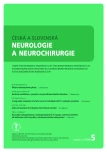Decompressive craniectomy in malignant middle cerebral artery infarction – monoinstitutional retrospective analysis of a set of 33 patients
Authors:
K. Pištěk; M. Sameš
Authors‘ workplace:
Neurochirurgická klinika FZS UJEP, a Krajské zdravotní a. s. – Masarykovy, nemocnice v Ústí nad Labem, o. z.
Published in:
Cesk Slov Neurol N 2020; 83/116(5): 559-562
Category:
Short Communication
doi:
https://doi.org/10.14735/amcsnn2020559
Overview
Aim: Decompressive craniectomy is a method of choice in the treatment of malignant middle cerebral artery infarction. Based on the conclusions of the three European prospective trials DECIMAL, DESTINY and HAMLET and their pooled analysis, we performed a retrospective analysis for years 2014–2018 at our department to assess the clinical outcome of patients who underwent decompressive craniectomy for malignant middle cerebral artery infarction. Patients and methods: The set consisted of 33 patients.
Results: 22 operated patients died as a result of the disease, three patients were grade 4 and four patients grade 3 on the modified Rankin Scale. Four patients had to be excluded from the cohort. We monitored parameters such as the patient’s age at time of stroke, the time that had elapsed since the clinical manifestation and since determination of diagnosis according to CT to the start of surgery and midline shift on CT. We performed a statistical analysis of the baseline data, but these were not entirely beneficial for a probably small group of patients.
Conclusion: In general, in line with the findings of European studies, the patient’s age at stroke onset (below 60 years) and the time elapsed from the clinical manifestation and from graphic signs of ischemia to the start of decompressive craniectomy (less than 48 h) are essential positive prognostic factors.
Keywords:
indications – decompressive craniectomy – malignant middle cerebral artery infarction – retrospective analysis
Sources
1. Moulin DE, Lo R, Chiang J et al. Prognosis in middle cerebral artery occlusion. Stroke 1985; 16 (2): 282–284. doi: 10.1161/01.str.16.2.282.
2. Frank JI. Large hemispheric infarction, deterioration, and intracranial pressure. Neurology 1995; 45 (7): 1286–1290. doi: 10.1212/wnl.45.7.1286.
3. Hacke W, Schwab S, Horn M, et al. Malignant middle cerebral artery territory infarction: clinical course and prognostic signs. Arch Neurol 1996; 53 (4): 309–315. doi: 10.1001/archneur.1996.00550040037012.
4. Berrouschot J, Sterker M, Bettin S et al. Mortality of space-occupying („malignant“) middle cerebral artery infarction under conservative intensive care. Intensive Care Med 1998; 24 (6): 620–623. doi: 10.1007/s001340050625.
5. Hofmeijer J, van der Worp HB, Kappelle LJ. Treatment of space-occupying cerebral infarction. Crit Care Med 2003; 31 (2): 617–625. doi: 10.1097/01.CCM.0000050446.16158.80.
6. Schwarz S, Schwab S, Bertram M et al. Effects of hypertonic saline hydroxyethyl starch solution and mannitol in patients with increased intracranial pressure after stroke. Stroke 1998; 29 (8): 1550–1555. doi: 10.1161/01.str.29.8.1550.
7. Schwarz S, Georgiadis D, Aschoff A et al. Effects of body position on intracranial pressure and cerebral perfusion in patients with large hemispheric stroke. Stroke 2002; 33 (2): 497–501. doi: 10.1161/hs0202.102376.
8. Schwab S, Spranger M, Schwarz S et al. Barbiturate coma in severe hemispheric stroke: useful or obsolete? Neurology 1997; 48 (6): 1608–1613. doi: 10.1212/wnl.48.6.1608.
9. Vahedi K, Vicaut E, Mateo J et al. Sequential-design, multicenter, randomized, controlled trial of early decompressive craniectomy in malignant middle cerebral artery infarction (DECIMAL Trial). Stroke 2007; 38 (9): 2506–2517. doi: 10.1161/STROKEAHA.107.485235.
10. Jüttler E, Schwab S, Schmiedek P et al. Decompressive surgery for the treatment of malignant infarction of the middle cerebral artery (DESTINY): a randomized, controlled trial. Stroke 2007; 38 (9): 2518–2525. doi: 10.1161/STROKEAHA.107.485649.
11. Hofmeijer J, Kappelle LJ, Algra A et al. Surgical decompression for space-occupying cerebral infarction (the Hemicraniectomy After Middle Cerebral Artery infarction with Lifethreatening Edema Trial [HAMLET]): a multicentre, open, randomized trial. Lancet Neurol 2009; 8 (4): 326–333. doi: 10.1016/S1474-4422 (09) 70047-X.
12. Poca MA, Benejam B, Sahuquillo J et al. Monitorin intracranial pressure in patients with malignant middle cerebral artery infarction: is it useful? J Neurosurg 2010; 112 (3): 648–657. doi: 10.3171/2009.7.JNS081677.
13. Jüttler E, Unterberg A, Woitzik J et al. Hemicraniectomy in older patients with extensive middle-cerebral-artery stroke. N Engl J Med 2014; 370 (12): 1091–1100. doi: 10.1056/NEJMoa1311367.
14. Vahedi K, Hofmeijer J, Jüttler E et al. Early decompressive surgery in malignant infarction of the middle cerebral artery: a pooled analysis of three randomized controlled trials. Lancet Neurol 2007; 6 (3): 215–222. doi: 10.1016/S1474-4422 (07) 70036-4.
15. Škoda O, Herzig R, Mikulík R et al. Klinický standard pro diagnostiku a léčbu pacientů s ischemickou cévní mozkovou příhodou a s tranzitorní ischemickou atakou – verze 2016. Cesk Slov Neurol N 2016; 79/112 (3): 351–363. doi: 10.14735/amcsnn2016351.
16. Mraček J. Indications for decompressive craniectomy. Cesk Slov Neurol N 2016; 79/112 (1): 7–21. doi: 10.14735/amcsnn20167.
17. Náhlovský J et al. Neurochirurgie. Praha: Galén 2006; 229
18. Göttsche J, Flottmann F, Jank L et al. Decompressive craniectomy in malignant MCA infarction in times of mechanical thrombectomy. Acta Neurochirurgica 2020; 162 (12): 3147–3152. doi: 10.1007/s00701-019-04180-0.
Labels
Paediatric neurology Neurosurgery NeurologyArticle was published in
Czech and Slovak Neurology and Neurosurgery

2020 Issue 5
Most read in this issue
- Diffuse low grade gliomas
- Respiratory rehabilitation in patients with amyotrophic lateral sclerosis
- Amnesia Light and Brief Assessment (ALBA) test – the second version and repeated examinations
- Neurorehabilitation in patients with amyotrophic lateral sclerosis
